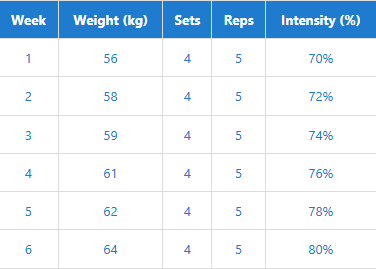Hit a plateau in your fitness journey? It’s probably because you’re not tracking progress the right way. That’s where the Progressive Overload Planner comes in — your personal roadmap to smarter, faster gains.
Whether your goal is strength, muscle growth (hypertrophy), or endurance, this tool helps you break through barriers by calculating weekly progress in weight, reps, sets, and training volume — all based on your current performance.
📈 No more guesswork — just science-backed progression made simple.
🎯 Ready to take control of your gains? Use the planner below and build smarter, not harder.
Progressive Overload Planner Free
Best Progressive Overload Planner
What Is a Progressive Overload Planner and How Does It Work?
Progressive overload is the backbone of any effective training program. It means gradually increasing the stress placed on your muscles over time. Without it, your muscles adapt — and stop growing.
A Progressive Overload Planner is a tool that helps you:
- Track increases in weight, reps, sets, or intensity
- Visualize your weekly improvements
- Set realistic progression goals
- Avoid injury from overtraining
Our tool uses your current 1RM (One Rep Max), training frequency, and goals to auto-calculate a personalized progression curve.
Progressive Overload Planner Chart

Why Progressive Overload Matters for Strength and Muscle Growth
Studies show that consistent overload leads to hypertrophy, improved neuromuscular efficiency, and greater overall strength. When your training variables remain the same week after week, your body has no reason to adapt. This is where most people stall.
Benefits include:
- Constant strength improvement
- More muscle definition and mass
- Injury prevention through smart programming
- Better motivation from visible progress
Progressive overload is not just for bodybuilders — it’s for anyone serious about improvement.
Progressive Overload by Training Goal: Hypertrophy, Strength, or Endurance?
Different goals need different overload tactics:
- Hypertrophy: Moderate weight, higher reps (6–12), progressive volume increase
- Strength: Heavy weight, low reps (3–6), progressive intensity increase
- Endurance: Light weight, high reps (12–20), progressive time-under-tension
First, calculate your 1 Rep Max Calculator to find your true starting point — this gives you an accurate baseline for planning. Then, choose your training frequency (e.g. 3x/week), select your goal (strength, hypertrophy, endurance), and let the planner calculate your weekly increases. Track and adjust based on your performance.
Our planner adapts based on which of these you’re aiming for.
How to Create a Progressive Overload Plan (Step-by-Step)
Creating a plan doesn’t need to be complicated. Here’s how to do it using our planner:
- Enter your current 1RM or working set weight
- Choose your training frequency (e.g. 3x/week)
- Select your goal (strength, hypertrophy, endurance)
- Let the planner calculate your weekly increase in reps/weight/volume
- Track and adjust weekly based on feedback or performance
This process takes less than 2 minutes — and it’s backed by data.
What Is the 3 2 1 Progressive Overload Workout?
This method structures training intensity across 3 weeks:
- Week 1: Moderate intensity (3 sets)
- Week 2: Higher intensity (2 heavier sets)
- Week 3: Max intensity (1 top set to near failure)
It’s used in powerlifting and advanced strength programs to stimulate nervous system adaptation while reducing fatigue.
Our planner can auto-adjust your volume based on similar cyclical systems.
How to Balance Volume, Intensity, and Frequency in Your Plan
To avoid burnout or overtraining:
- Don’t increase all variables at once
- Use auto-regulation: Listen to fatigue markers (RPE, soreness)
- Adjust frequency based on recovery (e.g., 2–4x/week per muscle group)
The planner takes your training load and provides built-in progression suggestions.
Example Weekly Progressive Overload Plans (Using Our Tool)
Example: Beginner Strength Program
- Week 1: 100 lbs x 5 reps x 3 sets
- Week 2: 105 lbs x 5 reps x 3 sets
- Week 3: 110 lbs x 5 reps x 3 sets
Example: Hypertrophy Plan
- Week 1: 70% 1RM x 10 reps x 4 sets
- Week 2: 70% 1RM x 11 reps x 4 sets
- Week 3: 75% 1RM x 8 reps x 4 sets
Use our tool to create custom plans in under 60 seconds.
Common Mistakes When Applying Progressive Overload
- Increasing weight too quickly
- Ignoring rest and recovery
- Using poor form under heavier loads
- Not tracking progress objectively
Our tool eliminates most of these errors by providing a clear roadmap.
Expert Tips to Maximize Overload Without Injury
- Use proper warm-up sets before max efforts
- Stick to a 5–10% increase weekly
- Program deload weeks every 4–6 weeks
- Use RPE or RIR for intensity control
These principles are baked into the planner’s logic.
FAQ: Progressive Overload Planner Questions Answered
How often should I increase weight?
Ideally every 1–2 weeks, depending on recovery.
Can beginners use this planner?
Absolutely — it’s built for all levels.
Is it useful for home workouts?
Yes, you can use reps and tempo overload with bodyweight too.
Should I deload? How often?
Every 4–6 weeks to allow full recovery.
Can I use this planner for running or cardio?
Yes, track time, pace, or distance as overload metrics.
Conclusion: Start Building Smarter Today
If you want results, you need structure. Our Progressive Overload Planner isn’t just a calculator — it’s a complete system to help you train with purpose, track your progress, and stay injury-free. Start using the tool today and build your strongest body — one week at a time.
🎯 Use the planner above and get your gains on track now.